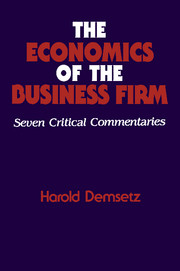Book contents
- Frontmatter
- Contents
- Preface
- First commentary: The firm of theory: its definition and existence
- Second commentary: Agency and nonagency explanations of the firm's organization
- Third commentary: Enterprise control, wealth, and economic development
- Fourth commentary: Profit maximization and rational behavior
- Fifth commentary: The use and abuse of accounting profit data
- Sixth commentary: Management compensation and tournament theory
- Seventh commentary: The intensity and dimensionality of competition
- References
- Index
First commentary: The firm of theory: its definition and existence
Published online by Cambridge University Press: 06 July 2010
- Frontmatter
- Contents
- Preface
- First commentary: The firm of theory: its definition and existence
- Second commentary: Agency and nonagency explanations of the firm's organization
- Third commentary: Enterprise control, wealth, and economic development
- Fourth commentary: Profit maximization and rational behavior
- Fifth commentary: The use and abuse of accounting profit data
- Sixth commentary: Management compensation and tournament theory
- Seventh commentary: The intensity and dimensionality of competition
- References
- Index
Summary
The central theory of economics remains the neoclassical theory. It is essentially a theory that imparts much understanding about the price system as an allocator of resources, but it also contains a simple model of the business firm. Why is there a firm in the theory of price? What defines the firm in this theory? This, the first commentary of the present volume, is the proper place to settle these two epistemological issues. How I do settle them is at considerable variance from the manner that has become popular in the newly emerging theory of the firm. The answers to these questions lead quite naturally to the second commentary, which deals with theories of the internal organization of firms. Modern treatments of the firm do not cleanly separate the organization of the firm from the question of its existence. In the writing of this volume, I have become convinced that mixing these two issues is a source of confusion. Just as a theory of the existence of the atom need have no close relationship to a theory of the inner workings of its electron system, so an explanation for the existence of the firm may have little to do with an explanation of the firm's inner organization.
The most important example of comingling these two issues is found in R. H. Coase's 1937 classic article, “The Nature of the Firm.” Coase sets his task explicitly at the beginning of part II of his article.
- Type
- Chapter
- Information
- The Economics of the Business FirmSeven Critical Commentaries, pp. 1 - 14Publisher: Cambridge University PressPrint publication year: 1995
- 2
- Cited by



